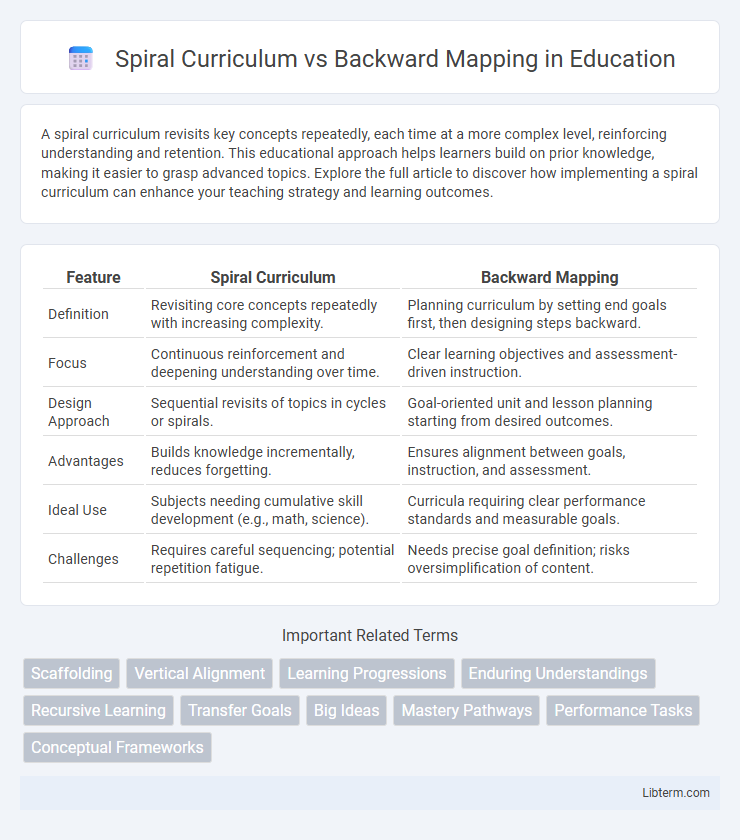A spiral curriculum revisits key concepts repeatedly, each time at a more complex level, reinforcing understanding and retention. This educational approach helps learners build on prior knowledge, making it easier to grasp advanced topics. Explore the full article to discover how implementing a spiral curriculum can enhance your teaching strategy and learning outcomes.
Table of Comparison
| Feature | Spiral Curriculum | Backward Mapping |
|---|---|---|
| Definition | Revisiting core concepts repeatedly with increasing complexity. | Planning curriculum by setting end goals first, then designing steps backward. |
| Focus | Continuous reinforcement and deepening understanding over time. | Clear learning objectives and assessment-driven instruction. |
| Design Approach | Sequential revisits of topics in cycles or spirals. | Goal-oriented unit and lesson planning starting from desired outcomes. |
| Advantages | Builds knowledge incrementally, reduces forgetting. | Ensures alignment between goals, instruction, and assessment. |
| Ideal Use | Subjects needing cumulative skill development (e.g., math, science). | Curricula requiring clear performance standards and measurable goals. |
| Challenges | Requires careful sequencing; potential repetition fatigue. | Needs precise goal definition; risks oversimplification of content. |
Introduction: Understanding Curriculum Design Approaches
Spiral Curriculum emphasizes revisiting key concepts repeatedly with increasing complexity, enhancing long-term retention and deepening understanding over time. Backward Mapping starts with defining desired learning outcomes and then designs instructional activities to achieve those goals, ensuring alignment between objectives and assessments. Both approaches strategically guide curriculum development to support effective learning pathways.
Defining Spiral Curriculum: Key Concepts and Principles
Spiral curriculum is an instructional design strategy where key concepts are revisited repeatedly over time with increasing complexity and depth, enabling reinforced learning and retention. This approach emphasizes the progressive building of knowledge by connecting prior understanding to new information, fostering deeper comprehension and skill development. Key principles include cumulative learning, spaced repetition, and the integration of foundational concepts throughout the educational journey.
Exploring Backward Mapping: Foundations and Objectives
Backward mapping emphasizes starting curriculum design with desired learning outcomes and competencies, ensuring instructional activities and assessments align closely with these goals. This approach fosters clear, targeted educational pathways by identifying key objectives first, which supports precise evaluation and meaningful skill development. Its foundational goal is to enhance student mastery by connecting daily teaching practices directly to long-term educational standards and benchmarks.
Core Differences Between Spiral Curriculum and Backward Mapping
Spiral Curriculum emphasizes revisiting core concepts at increasing levels of complexity to reinforce learning and deepen understanding over time, while Backward Mapping starts with defining desired learning outcomes and designs instruction by aligning assessments and activities to those goals. The core difference lies in the approach: Spiral Curriculum focuses on iterative content reinforcement, whereas Backward Mapping centers on outcome-driven planning from the end goals backward. This fundamental contrast shapes curriculum design strategies, influencing both teaching methods and assessment alignment.
Advantages of Spiral Curriculum in Educational Practice
Spiral Curriculum enhances long-term retention by revisiting key concepts at increasing levels of complexity, allowing learners to build deeper understanding over time. It supports differentiated instruction by reinforcing foundational knowledge before introducing advanced topics, catering to diverse learning paces. This approach promotes cumulative learning and improves student engagement through repeated exposure and continuous skill development.
Benefits of Backward Mapping for Curriculum Planning
Backward Mapping enhances curriculum planning by starting with clear learning objectives, ensuring all teaching activities and assessments directly align with desired outcomes. This approach promotes focused instruction and maximizes student mastery of essential skills, reducing content overload. Educators benefit from streamlined lesson design and improved coherence in curriculum delivery, leading to measurable student achievement improvements.
Challenges Faced in Implementing Spiral Curriculum
Implementing a Spiral Curriculum presents challenges such as ensuring consistent reinforcement of concepts at increasing complexity levels, which demands meticulous curriculum design and teacher training. It requires alignment across grade levels to prevent gaps or repetition that could confuse students, along with adequate assessment strategies to monitor progress through spiraled content. Resistance from educators accustomed to traditional linear approaches and the need for ongoing professional development further complicate effective execution of the Spiral Curriculum model.
Obstacles and Solutions in Backward Mapping Application
Backward Mapping faces obstacles such as resistance from educators unfamiliar with starting curriculum design from outcomes rather than content, and challenges in aligning assessments strictly to predefined goals. Solutions include professional development focused on outcome-based education and collaborative planning sessions that bridge content expertise with goal-setting. Utilizing clear, measurable learning objectives and frequent feedback loops enhances fidelity and adaptability in Backward Mapping application.
Choosing the Right Approach: Factors for Educators to Consider
Choosing between Spiral Curriculum and Backward Mapping depends on factors such as student readiness, content complexity, and learning objectives. Spiral Curriculum supports gradual skill reinforcement with recurring themes, ideal for developing deep understanding over time. Backward Mapping emphasizes end goals and assessment outcomes, benefiting educators focused on mastery and measurable learning benchmarks.
Conclusion: Optimizing Curriculum Design for Effective Learning
Spiral Curriculum enhances long-term retention by revisiting key concepts with increasing complexity, while Backward Mapping ensures alignment with desired learning outcomes by designing assessments and activities from the end goals backward. Combining these approaches optimizes curriculum design by providing a structured yet flexible learning pathway that reinforces knowledge and skills progressively while maintaining clear objectives. Effective curriculum development integrates iterative concept reinforcement with outcome-driven planning to maximize student engagement and mastery.
Spiral Curriculum Infographic

 libterm.com
libterm.com